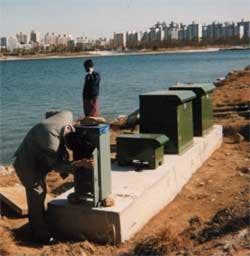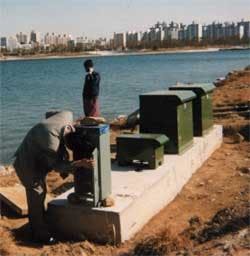India cleans up polluted lakes and rivers
By Robert Laing
The US company Clean-Flo International won the Innovation in Environment Technology Award, sponsored by the Wisitex Foundation last March for its successful restoration of ten freshwater lakes in India that were heavily polluted by nutrients, such as nitrogen and phosphorus. The foundation is located in New Delhi and promotes technology that solves problems in India.
Ten years ago, Clean-Flo and French engineers used the same restoration approach using Continuous Laminar Flow Inversion and Oxygenation, to restore the highly polluted Helpe River in France, which won two environmental awards for the mayor of Fourmies. As a result of this and other Clean-Flo projects, the United States - Asian Environmental Partnership (US-AEP), introduced the technology to India.
"We identified this technology as most appropriate to clean India's grossly polluted lakes, reservoirs, rivers and canals," said Captain Von Millard, the former India director of US-AEP. "We brought Clean-Flo over on an educational exchange to address their technical solution to lake restoration . . . a positive response was found," he added.
Millard's interest was first sparked when US-AEP in Washington sponsored a delegation of environmental scientists from Sri Lanka to India in 2001 to study a lake that Clean-Flo had restored near Mumbai. Kachrali Lake in Thane was a highly eutrophic four-hectare lake with algal blooms, and its surface was about 70% covered with water hyacinth. Bottom water was anaerobic, causing a massive release of phosphorus and nitrogen from the sediment along with objectionable odour.
The Clean-Flo Continuous Laminar Flow Inversion and Oxygenation System was installed in January 1999, and nitrogen and phosphorus-feeding bacteria were added a few weeks later. The lake cleared of water hyacinth and vastly improved over its original condition. Water hyacinth seeds at the bottom of the lake can no longer germinate because of the excellent water quality. As a result, the delegation of scientists from Sri Lanka wanted to inspect the lake to learn more about the Clean-Flo system.
The system also removes organic muck, significantly improving fish growth and health, reducing aquatic weeds, algae, foul odours and disease-causing bacteria. In India, a severe problem is malaria caused by mosquitoes feeding in highly polluted water. By increasing fish life, the fish feed on mosquito larvae.
Millard immediately set up meetings for Robert Laing, CEO and founder of Clean-Flo, with officials from federal, state and municipal environmental agencies, the World Bank, World Health Organization and a university in Hyderabad. For three months, he travelled to Mumbai, Kolkata (formerly Calcutta), New Delhi, Bangalore, Hyderabad, Chennai and Kerala to discuss water body restoration solutions and learned about on-going river and water conservation projects.
Following those meetings, the India National River Conservation Department and state pollution control boards made several concrete proposals. Clean-Flo restored ten lakes in India up to 210 hectares, and is anticipating several new projects presently being considered by governmental agencies.
The energy-efficient Continuous Laminar Flow Inversion and Oxygenation process enables various Clean-Flow biological products to perform their functions, as needed. Unlike ordinary diffused air systems such as surface aeration, paddlewheels, hypolimnetic aerators, or propeller-aspirator aerators, the process oxygenates an entire body of water from top to bottom. It oxygenates and rids the entire bottom of gases, including ammonia and carbon dioxide, which aquatic weeds and algae need for food.
The process duplicates natural spring and fall turnover of lakes. In tropical countries, natural inversion occurs at random with typhoons, cyclones and torrential rains. Natural inversion oxygenates the bottom water and rids the water of toxic gases that accumulate in stagnant water. Natural twice-a-year inversion of lakes is increased to several times a day or several times a week or month. The amount of inversion depends on a specific engineering design to counteract incoming pollutants and pollutants in a particular body of water.
The process carries oxygenated, toxic gas-free surface water down to the bottom of the water body. At the bottom, oxygenated water binds phosphorus and nitrogen to the sediments and kills anaerobic, often pathogenic (disease-producing), bacteria that produce acids and toxic gases. Phosphorus and nitrogen in the water body is reduced three to twenty times as much as point-source watershed treatment can accomplish.
Author's noteRobert Laing is the chief executive officer and founder of Clean-Flo International, based in Brooklyn Park, Minnesota, USA.


